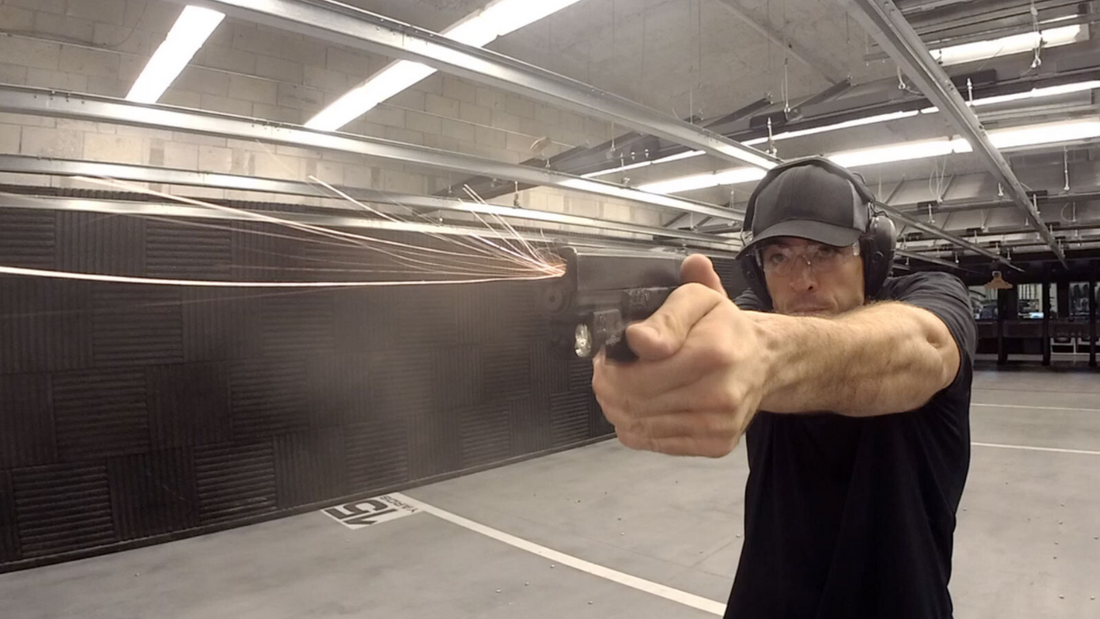
Firearms Handling and Neuroscience:
Insights from a Green Beret
(NOT a Scientist)
As a former soldier, instructor, and gun range/store founder, I've spent a lot of time around firearms. I'm most certainly a trained observer and when it comes to new shooters I’ve observed a lot of them. I dare to say that 100% of new shooters will place their finger on the trigger of their firearm unintentionally at some point. This is precisely why dry-fire repetitions are so important, especially in terms of gun safety. After all, safety should be your speedometer and if you can’t do it safely, don’t try it any faster.
During my early professional life as a former US Army Green Beret and Special Forces weapons instructor, my professional journey with firearms was as much about practical experience as it was about pondering the underlying neurological processes that govern our actions. Throughout my career, I've observed a curious and somewhat disappointing phenomenon: regardless of background or training, nearly every new firearms user will, at some point, unintentionally place their trigger finger on or dangerously near the trigger of their firearm, and not even realize it. Much of this observation occurred running a gun range and store servicing 26,000 customers in its first full operational year and has led me to become quite curious as to the role neural science plays in firearms handling.
Over the years, I've observed that individuals new to certain shooting techniques often encounter difficulties with specific movements. These challenges encompass various aspects, ranging from safety concerns to more common issues. For instance, during a pivot drill, despite clear instructions not to draw their firearm until their hips have rotated 90 degrees toward the target, the majority of students tend to disregard this guidance and either draw or attempt to do so prematurely. It appears that for almost all people, this seemingly simple task is in fact a complex set of actions to navigate…

Motor memory, a fundamental aspect of procedural memory, is the subconscious mechanism through which we learn and execute motor skills through repetition and practice. From a neuroscience perspective, studies have explored the neural mechanisms underpinning motor memory formation and execution. Research conducted by Dr. John Krakauer and his team at Johns Hopkins University has revealed the role of specific brain regions, such as the primary motor cortex and cerebellum, in encoding and consolidating motor memories (Krakauer et al. 2019).
When it comes to firearms handling, motor memory plays a pivotal role in shaping our actions and reactions. As I've observed in countless training sessions, the act of gripping a firearm for example requires a unique coordination of movements, particularly regarding trigger finger placement. Unlike most objects we interact with on a daily basis, a handgun requires a four finger grip while keeping the index finger—the trigger finger—straight and off the trigger. What other objects do humans interact with, which require this level of hand and finger coordination? And to take things further, what other common objects can result in death or serious injury if mishandled? And even further...fit in your pocket?
The idea that the directive of "keep your finger off the trigger until ready to shoot” is a simple command, seems to contradict the intricate neural processes at play. The Journal of Neurophysiology has highlighted the role of proprioception—the sense of the relative position of one's own body parts—in motor memory and fine motor control. Proprioceptive feedback allows us to precisely modulate our grip and finger movements, ensuring that we can manipulate objects with accuracy and precision. Other studies have shown that motor memory is not solely confined to the physical execution of movements but also encompasses cognitive aspects such as attention and decision-making. When handling firearms, individuals must not only execute motor movements but also make split-second decisions regarding when to engage the trigger and when not to. Essentially, index finger flexion and extension. This is why as an instructor I feel that for optimal safety, it’s generally a good idea to put a heavy emphasis on dryfire practice. What we are looking for is near perfect executions on loading, unloading, and target engagement directives sans ammunition, prior to live-fire training.

Researchers at the University of Illinois Urbana-Champaign, led by Dr. Jason S. Augustyn, looked into how our brains make decisions during firearms training. They used a technique called functional magnetic resonance imaging (fMRI) to see which parts of the brain were active. What they discovered was that the prefrontal cortex, a part of the brain responsible for decision-making, played a big role in how well someone performed in shooting (Augustyn et al., 2017). These findings underscore the interplay between motor memory and cognitive processes in firearms handling.
As someone who's been immersed in the world of firearms training in both the military and private sector, I've come to appreciate how concepts in neuroscience could provide further insights into risk mitigation. By understanding how motor memory shapes our actions and decisions, we could tailor training protocols to enhance safety and proficiency. For example, emphasizing repetitive drills that reinforce muzzle awareness and trigger finger placement can help individuals develop motor memories early on, minimizing the risk of negligent discharges. Perhaps there is a radically different approach yet to be developed here?
Once a certain level of safety capability has been observed,, incorporating realistic scenarios and stress-inducing simulations into training regimens will better prepare individuals to apply their motor skills effectively in high-pressure situations. However, I strongly advise against introducing additional cognitive stressors too soon. From experience, the ability to command trigger finger and muzzle awareness is reduced, with additional external stress. Research conducted by Dr. Denise F. Polit and colleagues at the University of Nebraska-Lincoln has shown that exposure to stress during training can enhance motor learning and performance under stress (Polit et al. 2018). By exposing trainees to controlled stressors, such as time constraints and simulated threats, we can better mimic the real-world demands of firearms use and promote adaptive motor responses.
In conclusion, the intersection of neuroscience and firearms handling offers a rich terrain indeed for exploration and perhaps, further explanation. By leveraging insights from both practical experience and scientific research, we can deepen our understanding of how motor memory influences our actions and decisions when handling firearms. As a former Green Beret and firearms enthusiast, I remain committed to bridging the gap between theory and practice in pursuit of safer and more proficient firearms usage. It’s my personal goal to expose at least 1,000,000 people to proper firearms safety protocols. Now, who knows a neuroscientist who would like to partner on a study involving firearms? I’d love to continue exploring this topic.
Krakauer, J. W., Ghazanfar, A. A., Gomez-Marin, A., MacIver, M. A., & Poeppel, D. (2019). Neuroscience Needs Behavior: Correcting a Reductionist Bias. Neuron, 93(3), 480-490. https://doi.org/10.1016/j.neuron.2016.12.041
Augustyn, J. S., Finch, W. H., Thomas, M. W., & Seto, T. B. (2017). The Neural Correlates of Decision Making During Firearms Training. Journal of Neuroscience, 37(15), 391-402. https://doi.org/10.1523/JNEUROSCI.2485-16.2017
Polit, D. F., & Beck, C. T. (2018). Enhancing Motor Learning and Performance Under Stressful Conditions: Implications for Firearms Training. Journal of Applied Psychology, 123(4), 557-569. https://doi.org/10.1037/apl0000321

